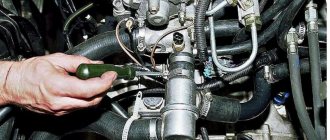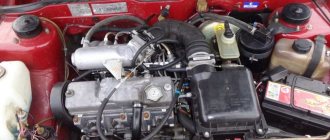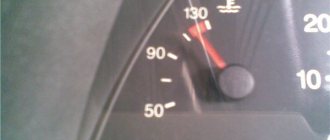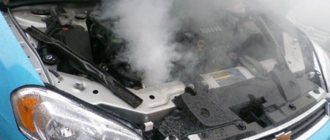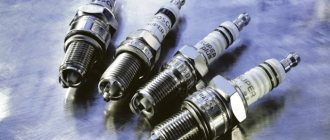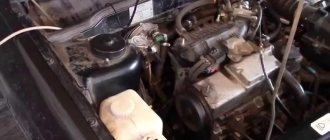Almost every motorist has come across the concept of engine overheating, but not everyone knows why it occurs. Also, in this article we will talk about how to avoid such a phenomenon on a Lada Kalina car (regardless of whether it has an 8 or 16 valve engine, the reasons are basically always the same), correct faults and consider the recommendations of experts and the experience of motorists. The main reason why overheating occurs (4th error on the instrument panel) is a malfunction in the engine cooling system, as well as, in rare cases, accumulated errors in the engine control unit. So, let's look at the main reasons for overheating of the main power unit of the Lada Kalina: 1
. Clogged engine cooling radiator and cooling lines.
2
.
Stretched water cooling belt, as well as pump malfunction. 3
. Stuck thermostat.
Diagram of the working thermostat.
If there is a malfunction, it jams into a small circle, which is why the car gets very hot 4
. Failure of the engine cooling sensor.
Location of the coolant sensor
5
. Cooling fan malfunction. May be caused by a broken fan relay or blown fan fuse.
Cleaning the cooling radiator from debris
All these elements are part of the cooling system, which can fail and lead to engine overheating.
But there are other reasons that lead to internal overheating of the power unit. There are several of them: 1
.
Large volumes of deposits inside the combustion chamber. This problem usually occurs in old cars that have traveled hundreds of thousands of kilometers. Excessive oil enters the engine combustion chamber. The latter burns poorly and leaves a harmful coating on the cylinder walls. As a result, the engine overheats, but the temperature sensor does not sense this and does not give a signal to the driver. The problem will only be noticeable if additional signs appear—blue smoke from the exhaust pipe or malfunctions in the power unit. 2
.
Plaque in the cooling cavity. If you pour water into the cooling system or low-quality antifreeze, then deposits may appear on the walls of the components and tubes, which disrupts the cooling processes. As a result, many channels may be blocked, and the access of fluid to the system is disrupted. A deposit of mineral salts leads to a sharp decrease in the quality of engine cooling and, as a result, its overheating. 3
. Oil additives. There are car enthusiasts who thoughtlessly add additives to motor oil, without even knowing their true purpose. As a result, a powerful coating can form on the cylinder walls, which disrupts the quality of engine cooling and leads to its inevitable overheating.
The importance of using antifreeze
Monitor the antifreeze level
External engine overheating can occur for a number of reasons, and one of the main ones is insufficient antifreeze in the cooling system. Antifreeze can leak out easily because it has the structure of a regular liquid. Therefore, it is necessary to constantly monitor the integrity of the hoses and their fastenings.
Try to pay attention to the surface where the car has been standing for a long time. Light spots on it indicate a coolant leak. If such signs are detected, it is necessary to urgently check the integrity of all elements of the cooling system. If antifreeze leaks into one of the engine cylinders or into the oil compartment, serious complications are quite possible.
If you do not use antifreeze, but fill the cooling system with distilled water, you should not use hard water, which contains a large amount of minerals and salts. You risk ruining even a new thermostat after only 3-4 thousand kilometers.
Return to contents
What are the consequences of engine overheating?
As a rule, the consequences of engine overheating depend on the efficiency of the motorist. The less the power unit operates in a dangerous mode, the lower the likelihood of damage to its units. For example, if the engine has been running in overheating mode for up to ten minutes, then you should not expect any serious problems - the engine and its components must withstand the effects of elevated temperatures with dignity. The worst that can happen is a slight melting of the piston surface. If, during the process of overheating, smoke poured out from under the hood, then it is better to show the car to a mechanic. In the case where the engine has been running under overheating conditions for about twenty minutes, the consequences can be more serious. The most common malfunctions in this case are the appearance of cracks in the cylinder head, its curvature, burnout of the gasket between the cylinder head and the block itself, damage to the seals, defects in the inter-ring partitions, and so on.
Note! That severe overheating can lead to catastrophic consequences - it is tantamount to a “heart attack.” Failures can begin directly from the combustion chamber and completely immobilize the power unit.
The piston system begins to melt, and traces of burnout appear. Melted aluminum sticks to the cylinder walls and further complicates engine operation. High temperatures lead to severe overheating of the oil. The result is the loss of all its lubricating characteristics and failure of rubbing parts. The connecting rod and main bearings begin to stick to the crankshaft, which also melt under high temperatures. And the crankshaft itself may not hold up and fall apart into several parts. The worst that can happen is that the connecting rod breaks through the wall of the cylinder block. Then you can put a “cross” on the engine.
Driver actions in case of overheating
The most important thing a car owner must do is to ensure that the car stops. And you need to finish the movement in a timely manner, since the rising temperature will definitely lead to overheating.
The driver's actions then look like this:
- The air conditioning and additional devices, such as the radio, headlights, heated seats and glass, are turned off.
- The stove turns on at the highest speed. This will remove some of the heat.
- If the temperature continues to rise or the reason is not obvious, then it is better to turn off the engine and inspect the engine compartment. This may not provide a complete answer to what happened, but it will save the car owner’s money, since the worst consequences of overheating will not be allowed to happen.
Further movement is possible only if the problem is identified. If this is a broken pipe or another problem that clearly indicates the need to add antifreeze, then it must be eliminated and liquid added to the system. There should be no extraneous sounds coming from the car in the form of gurgling, popping or knocking.
Video: ENGINE OVERHEATING? IS THE MOTOR BOILING? / THERE IS A SOLUTION!
Causes of external overheating of the Kalina engine
Engine overheating can be caused by extremely low circulation of cold air inside the radiator. Most often this is due to the power supply to the ventilation system. In particular, the sensor that controls the speed of rotation of the blades fails. In this case, you need to check the degree of tension of the belt that connects the ventilation sensor and the crankshaft. If everything is in order with the belt drive, you need to pay attention to the level of contamination of the radiator and, if necessary, clean the unit. The above actions will be useless only if the radiator has completely outlived its useful life. In this case, the unit will need to be replaced with a new one.
Overheating can occur as a result of warping of the engine head seal or cylinder block lining. Other reasons: overheating or damage to the unit. If you do not contact a service station in time, there is a possibility of engine water hammer or crankshaft destruction.
The motor may overheat if the temperature sensor is faulty. Over time, sediment builds up in every cooling system, preventing the thermostat sensor from moving freely. Eventually it stops responding to the temperature level of the antifreeze inside the engine. In this case, the thermostat will circulate antifreeze through a small circuit, thereby reducing the cooling efficiency of the engine. This may not have any effect on the engine in the cold season, but in warmer weather the engine will overheat.
Another reason why the engine heats up may be excessive valve burnout. The fact is that the operation of the internal combustion engine is based on the principle of cyclical combustion of fuel, which passes processed gases through the hole in the exhaust valve. These gases have an elevated temperature, which affects the overall heating of the engine of domestic cars.
The Lada Kalina engine heats up very quickly when it is overloaded in certain situations. For example, a car is used as a means of towing another vehicle or trailer. In addition, during the warm season, many people go on vacation to mountainous areas. At high temperatures, lifting the vehicle will require increased torque, which is achieved at low speed. As a result, the cooling system reduces its efficiency and the engine overheats.
The same fate will befall a car that sits for a long time in a stuffy traffic jam in an urban environment. The air under the hood heats up, and the lack of movement eliminates the possibility of intensive circulation.
Return to contents
Viburnum heats up to 100 degrees
You should monitor the engine temperature
Despite the high-quality assembly, the engine of each car can be subject to severe overheating. Many factors can lead to this outcome, especially high air temperatures during hot periods of the year.
Spare parts of the car engine and components interacting with it may fail, even if the permissible engine temperature has increased for a short time. Such situations must be warned in time to avoid unnecessary financial costs for updating parts. This means that you must always monitor the engine and its cooling system, eliminating any problems that arise.
The reasons for engine overheating in domestic cars can be either external or internal. Internal overheating poses the greatest threat because it is more difficult to detect. In such a situation, the antifreeze maintains its operating temperature, because the heat is present only inside the engine. In this case, the performance of the engine is greatly reduced, since the high temperature burns out the piston rings. As a result, this can lead to complete destruction of the motor from the inside.
Checking and repairing the Kalina engine cooling system
| The heater does not heat well, the coolant level drops below the MIN mark each time, the engine temperature does not rise to operating temperature, or the engine overheats? The causes of all these ailments are improper operation of the engine cooling system (ECS). We learn to identify and eliminate the causes of poor performance of the LADA Kalina SOD. |
Diagnostics of the LADA Kalina engine cooling system
When operating a vehicle, the technical condition of the cooling system can be assessed by looking at the coolant temperature gauge and the fluid level in the expansion tank. A decrease in coolant level is usually caused by a leak in the system. Some cars have a coolant level sensor installed. When the level drops to the MIN mark, the corresponding indicator lamp in the display unit of the on-board monitoring system lights up.
| 1. Checking the coolant level in the expansion tank. The liquid level should be 25 - 30 mm above the MIN mark on the expansion tank body. If the fluid level is at the MIN mark or below, add coolant to the reservoir |
Warning!
The coolant level should be checked on a cold engine. A slight increase or decrease in the coolant level during heating and cooling of the engine is not a malfunction. This is due to the thermal change in the volume of the liquid.
If you have to regularly add coolant, you should check the tightness of the cooling system.
2. Check the tightness of hoses and connections of the cooling system. Inspect the engine compartment and pay attention to the condition and tightness:
- Expansion tank hoses;
- Radiator drain holes and hoses;
- Heater radiator hoses;
- Engine cylinder block;
- Places for installing temperature sensors;
- Thermostat hoses.
3. Checking the integrity of the engine cooling system elements.
- Expansion tank housing;
- Engine radiator;
- Heater radiator;
- Connections between the coolant pump (pump) and the cylinder block. We also check that there is no leakage of liquid from the drainage hole of the pump (located at the bottom of the pump), indicating wear of its seal.
There should be no coolant leaks anywhere.
| 4. Checking the thermostat. We control the coolant temperature using the indicator on the instrument panel, and the circulation of the liquid in small and large circles by touch, by changes in the temperature of the hoses and pipes of the cooling system (in the photo the air filter is removed for clarity). |
Comment
If the engine cooling system is working properly, then when the coolant temperature is less than 90 ° C, the main thermostat valve should be closed and the coolant should circulate in a small circle. As a result, the lower radiator hose and the radiator itself will be noticeably cooler than the thermostat housing, through which hot coolant circulates. When the coolant temperature reaches about 90 °C, the main thermostat valve will open and a gradually increasing flow of hot liquid will begin to flow into the radiator. In this case, first the radiator and then its lower hose will begin to heat up.
Once the temperature reaches 102 °C, the main thermostat valve will fully open and all fluid flow will circulate through the radiator. In this case, the radiator will become hot in the upper zone and slightly cooler in the lower zone.
We leave the engine running until the engine radiator fan operates. When the coolant temperature rises to the point where the temperature gauge needle approaches the red zone, the electric fan should turn on, and when the temperature drops, it should automatically turn off.
Comment
If the electric fan does not turn on in time, the liquid boils, it is necessary to check the serviceability of the fan electric motor or the serviceability of the engine control system.
Malfunctions of the engine cooling system and how to eliminate them
| Cause of malfunction | Remedy |
| The engine gets very hot | |
| Reduced coolant level in the radiator | Add coolant |
| Thermostat valve stuck closed | Thermostat is faulty, replace. |
| Poor circulation of coolant in the system | Replacing the pump (coolant pump) |
| The radiator is clogged with insects and dirt | Cleaning the engine radiator from the outside |
| Radiator tubes, hoses and engine cooling jacket are clogged with scale and silty deposits | Flush the engine cooling system and add fresh coolant |
| The electric fan does not turn on due to a broken electrical circuit, failure of the temperature sensor, fuses, additional resistance, relay or fan motor | Check and restore electrical circuits. If necessary, replace the fuses, resistor, relay or electric fan assembly |
| Damage to the plug in the expansion tank cap (constantly open, causing the system to be under atmospheric pressure) | Replace the expansion tank cap |
| The engine overheats and cold air blows from the heater | |
| Excessively low coolant level due to a leak or damage to the cylinder head gasket, causing vapor locks to form in the engine water jacket | Repair coolant leak. Replace the damaged cylinder head gasket. |
| The engine does not warm up to operating temperature for a long time, the thermal regime is not stable while driving | |
| Thermostat valve stuck closed | Thermostat is faulty, replace. |
| Constant decrease in coolant level in the expansion tank | |
| Radiator leaking | Repair or replace radiator |
| Heater radiator leaking | Repair or replace heater core |
| Expansion tank leaking | Replace expansion tank |
| Coolant leakage through leaky connections of hoses and pipes | Replace the hose and pipe clamps |
| Damaged water pump seal | Replace the pump |
| The cylinder head bolts are not tightened sufficiently (on a cold engine during long-term parking, a coolant leak appears through the joint between the cylinder head and the cylinder block, in addition, traces of coolant may appear in the engine compartment) | Tighten the cylinder head bolts to the required torque. |
A more detailed design of the engine cooling system is discussed in a separate article. Keywords:
Causes in the thermostat
Engine cooling system on a Lada Kalina car.
A thermostat is a device that, depending on the temperature of the coolant, controls the cooling circuits .
- If the engine is cold , then circulation is carried out in a small circle , bypassing the main cooling radiator.
- As soon as the engine warms up to operating temperature , the thermostat opens and coolant begins to circulate in a large circle .
The path of the coolant (coolant) to the radiator pipe is blocked by a special valve, which is connected to the cylinder using a pin filled with technical wax. As the temperature rises, the wax melts, expands and pushes the pin, accordingly the valve opens, freeing the passage for coolant.
The same valve responsible for the passage of coolant.
The liquid begins to move in a large circle . The engine begins to gradually cool down, and when the temperature reaches the set minimum value, the valve closes again and the liquid moves in a small circle .
Symptoms of malfunction
Engine temperature diagram.
Signs of a bad thermostat may include coolant temperatures that are too low or too high.
- Engine overheating.
- It took longer to warm up the engine.
If you notice one of these symptoms, it is recommended to immediately check the operation of the thermostat.
In your case, the thermostat is always wide open . Therefore, it takes much longer to warm up. And when driving in severe frost, the engine does not have time to reach the operating range (88-90 degrees).
Hello everyone. Kalina 1.6.16kl I drive with the RB cap unscrewed (so as not to air out the system, the problem is this: Suddenly, for no apparent reason, the car started to warm up. And the heater cooled down when you start it in the morning for a while in the car Tashkent, and then the above listed appears .the thermostat operates at a temperature of 88, the lower pipe begins to warm up. I checked there is no air in the system several times. Could this be due to the pump? (from heating, the impeller begins to turn, etc.)
Well, due to heating, it is unlikely that this is possible with a pump. The level in the expansion tank does not change significantly? If you accelerate, a stream from a thin hose hits the expansion tank? If this stream is there, then the pump is normal.
There is a small trickle even at idle. When the temperature reaches 98-99 degrees, antifreeze starts to press out of the reservoir. The pipes are all hot. Right now I wanted to remove the air again. It’s stupidly gone. And again this crap doesn’t appear right away. I rode for an hour, everything was great. The temperature was 86. The stove is frying. Then I see the temperature is already 89-90 and the stove is cooling down. And so on until victory. I’ve already lost my mind
Well, that means you have an air lock again. The car heats up, starts to boil because of the airlock, the antifreeze leaves and air comes in.
You didn’t change the fan switching on in the ECU and it turns on as standard after 100 degrees?
The fan turns on at 98. but the car does not cool down. I have a guess that the coolant stops circulating. I removed the pipes from the throttle heating. I drove it up a hill. There is no air. Where does it come from if the plug is not closed (there is no vacuum). Unless there is a gasket. But there It’s a metal package. It can’t burn out in half a year. The car didn’t overheat. I always monitor the temperature
Replace the lower pipe, there may be internal delamination of the rubber. Delamination blocks the circulation of antifreeze flow. And perhaps the upper pipe has delaminated. It's up to you to decide which one. But this is only if everything is in order with the pump.
Maybe. Just last summer I just had to turn the impeller on the pump.
Last edited by rmx116; 01/23/2018 at 13:07 .
Have you changed the antifreeze recently? What's in it?
Why is the gasket only half a year old? Have you already taken off your head? Did you supply the factory metal gasket or 2112? Did you tighten it to the specified torque?
They installed a piston without a plug, but I honestly don’t remember what kind of cylinder head gasket they installed (but people there are not stupid, it’s probably still a metal package). I changed the antifreeze (Felix red) 2 months ago along with the heater radiator, at the moment the car does not smoke (condensation in the exhaust not sweetish). Doesn't stink of exhaust from the tank. Everything was fine for half a year. And then I was driving around the city, picked up a girl and noticed that the temperature was creeping up slowly. And the stove was getting colder and colder. As soon as I gave it gas. The stove heats up and after a while it starts again it's cooling down ps Yesterday everything was completely different. It all started the same way. Then the temperature hovered at 93, the stove cooled down at first, but then started to warm up. And as soon as I started driving, the car suddenly cooled down to 80 pss this morning everything was the same again: I started it from 50 degrees the stove starts to heat up, the car warms up to 86 and that’s it. I drove for a couple of hours and the temperature started to rise again. and the stove cooled down:
Last edited by InfernalSky; 01/24/2018 at 01:16.
My advice is the usual - install a computer board (at least the X1 staff for 1500 rubles), on it the fan switch-on temperature is 94 degrees. And don’t just unscrew the expansion cap, but completely pull the valve out of it. Screw on the cap itself normally. If the throttle is on a cable, then bleed the air from the throttle heating. That's it, drive like this. There will be no pressure in the system, plus there will definitely not be a boil and an air lock will form. If after this there are problems, take a closer look at the thermostat, pump and cylinder head gasket.
Well, if they opened the head, they could have stuck in a regular gasket and failed to tighten it. The symptoms look more like a gasket.
Causes of engine overheating | Car Hobby
The engine cooling system is one of the most demanding systems in a car. This is because it does not have an ideal design. Nothing new has been invented in terms of cooling yet, and therefore liquid cooling is predominant today. Its main problems are air locks and corrosion of the internal walls.
Most often, “boiling” cars can be seen in the city, during rush hour during traffic jams. Therefore, from time to time you need to look at the engine temperature sensor. When the temperature rises (in the heat, in a traffic jam), the electric fan should automatically turn on and fix this problem. If all elements of the engine cooling system are working properly, then the engine should not overheat.
But if the coolant temperature arrow does not stop rising and is already in the red area, then the engine must be turned off immediately. If you ignore this fact and continue driving further, the antifreeze will boil, the temperature in the area of the combustion chambers will rise sharply, the pistons will expand under the influence of high temperature and the engine will simply jam. The cylinder head may move (it will bend), and the gasket between the cylinder block and the head may crack. Considering how much a new engine costs now, it is better to avoid engine overheating.
If you notice in time that the coolant temperature arrow is at the red line, then overheating can be avoided. You can try turning on the stove at full power. The stove has its own radiator, this should remove some of the heat.
If some of the antifreeze has leaked out, it must be topped up to the required level. Driving with an empty cooling system is strictly prohibited. When topping up, do not unscrew the cap of the expansion tank while it is boiling. You risk serious burns. Wait until the engine cools down. And do not add cold antifreeze to hot antifreeze. This may damage the cylinder block.
The main reason for engine overheating is a broken thermostat. It does not open and does not allow liquid to pass through a larger circle. The heated coolant does not enter the radiator and is not cooled. In this case, the thermostat must be replaced.
Overheating can occur due to a breakdown of the fan or the sensor that turns it on. When driving at low speed, the air flow is not enough to cool the antifreeze and the fan must be turned on. If it is broken, overheating may occur.
The pump that circulates liquid through the cooling system may fail. It is better to change the pump during maintenance, knowing its service life.
The radiator could be clogged with dirt. This is especially true if you often drive through mud. In this case, the radiator must be washed. Be careful, it consists of a large number of small tubes that can be damaged very easily.
conclusions
The causes and methods of elimination, heating of the Lada Kalina engine in different modes are considered. So, the main reason remains the thermostat and radiator, which can fail. All other problems are purely individual and are determined through diagnostics and dismantling. You should not allow the engine to overheat, as this can adversely affect the operation of the power unit or cause it to fail.
I went to the garden after work. And water, and walk the cat for the first time.
It was +30, I was driving with air conditioning. The engine gets hot in traffic jams (it’s been like this since new - with a perfectly clean radiator - they say this happens on all vases). And then I remembered that I wanted to write one thing that everyone probably already knows, but suddenly.
During a trip to the Pamir Highway, on ascents, the engine temperature confidently crawled up to 100 degrees, sometimes higher. I fought this in a simple old-fashioned way: I turned the stove on full blast. The windows are open, so, to put it mildly, it’s not cold, but here you also get extra toasty.
Yes, it certainly brought down the temperature, but not as quickly as we would like. It would be more accurate to say that it didn’t just knock her down, but basically did not allow her to grow further. She lost her way very badly. And at some point a simple thought came to me: the car has air conditioning. There are two radiators, two fans... In general, I continued driving with air conditioning - on difficult sections I always turned it on. And the fan cooling the air conditioner radiator, in my opinion, is noticeably more powerful than usual. The first time it turned on, I even put down a few bricks. The engine temperature drops very quickly.
Yes, the air conditioner takes some power. But our ECU is smart. When you press the gas to the floor, it automatically turns off the air conditioning. This can be clearly heard by the click of the relay and the fact that the stuffiness begins again. You let go a little - another click of the relay, and again it blows cold air.
Almost every motorist has come across the concept of engine overheating, but not everyone knows why it occurs. Also, in this article we will talk about how to avoid this phenomenon, correct malfunctions and consider the recommendations of experts and the experience of motorists.
Video about possible causes of engine overheating:
The video material will tell you about the reasons for engine heating, elimination methods and recommendations.
Heat
If the engine temperature is too high, then you need to look for the cause of the breakdown. May work poorly:
- thermostat,
- water pump,
- blower fan,
- the radiator is clogged,
- coolant leaks appear.
Driving with an engine that is constantly heating up is even more dangerous than driving with an engine that is not warm enough. Therefore, all causes of overheating must be eliminated in a timely manner.
The following two tabs change content below.
- About the author:
- Latest articles:
I am the editor-in-chief of the site. In our editorial office: Hyundai Accent, Hyundai Solaris, Hyundai Santa FE (turbo-diesel 2015). I now have a Lada Kalina LUX (98 horses). A car fanatic, he has owned both left and right hand drive cars. Robots, CVTs, mechanics. The only thing missing was DSG. But it will be soon.
Similar materials
Tags: Questions Lada KalinaLada Kalina
Reliable engine insulation
If the engine freezes in winter, then the insulation is not at the proper level. By making high-quality insulation, you can save yourself from constantly warming up your car in the morning. Thermal insulation is placed between the grille and the radiator. What materials are suitable? You can take cardboard and insulating materials purchased at the store.
If the engine overheats or does not heat up, contact a specialist and the problem will be resolved. When a car's engine gets hot, the reasons can be serious. Timely identification of the cause will significantly increase the service life of the vehicle.
Why does the engine get hot from the inside?
Washed engine
The consequences of external engine overheating are not as serious as internal ones, since the temperature sensor on the dashboard will definitely report the problem. You saw that the arrow crossed the acceptable mark and took action. With overheating from the inside, everything is much more complicated; most often it leads to serious problems.
During vehicle operation, sediment accumulates in certain engine parts, resulting from the use of low-quality fuel or oil. For this reason, the engine is usually overhauled and cleaned after a certain mileage. The sediment collects mainly in the cylinder head. If the engine is not cleaned in time, the sediment will form a seal with poor thermal conductivity. In this case, the antifreeze circulation circuits are blocked, the coolant loses its effectiveness, and the thermostat fails. As a result, the engine heats up, although you don’t notice it.
Circuits blocked by sediment increase the likelihood of cooling coating cavitation. Cavitation is the process of damage to the metal shell of the engine, which most often becomes the cause of its detonation. Often mechanics may confuse cavitation with corrosion, but they are not the same thing.
The fundamental factor in internal engine overheating is burning out of the compartments in the cylinder block. In this case, a dense layer of deposits forms in the compartments, which creates the effect of thermal insulation. Typically, such problems arise in domestic cars with high mileage, that is, the engine begins to eat up more oil. As a result, the motor consumes only some of the resulting lubricant, and the rest forms seals. As the mileage increases, the engine overheats more and more, and the car owner does not even notice this, since the temperature indicator on the instrument panel is within the normal range.
One of the most destructive factors contributing to engine overheating is the regular use of additives. They often cause the formation of a dense metal-ceramic layer on the surface of the pistons. This coating has extremely low thermal conductivity. The presence of this factor alone already guarantees engine detonation.
Return to contents
conclusions
The causes and methods of elimination, heating of the Lada Kalina engine in different modes are considered. So, the main reason remains the thermostat and radiator, which can fail. All other problems are purely individual and are determined through diagnostics and dismantling. You should not allow the engine to overheat, as this can adversely affect the operation of the power unit or cause it to fail.
The car runs at idle and the temperature does not stay at 90, but starts to rise to 100, then the Carlson turns on and cools it a little. Then the same thing happens again. Is this a feature of Kalina Sport or what? Has anyone encountered this? Before this, my cars kept the temperature at a stable 90 and that’s it, but this one gets hot for some reason. Antifreeze is normal, it's not hot outside.
Cabin filter
Every car has a cabin filter. It is through it that heated air from the stove (or cold air from the air conditioner) enters the cabin. If there were no cabin filter, then debris and dust, and sometimes fat particles (products of oil evaporation, for example) from the engine compartment would fly into the cabin. If this filter hasn't been changed in years, then there is a good chance that it is simply clogged and needs to be replaced. Air simply cannot pass through a dirty filter into the cabin, so it is not surprising that the stove on the Kalina does not heat the air well.
Solving this problem is quite easy: you need to remove the cabin filter and install a new one. It is located under the hood of the car, at the top left (near the front passenger seat). It can be accessed with just one screwdriver, and the cabin filter itself is cheap (its price is about 200 rubles).
What to do before removing the plug.
First of all, you need to understand why an air lock forms, for this:
- We check for coolant leaks in the connections of the pipes, if there are any, we tighten the clamps or replace them.
- We check the coolant level in the expansion tank; for viburnums, it is advisable to keep the level at or slightly above the maximum.
- We check the correct operation of the expansion tank plug; if the air inlet plug does not work or with noticeable difficulty, then it is better to replace it; below I will explain in more detail about the plug.
- It is also advisable to check whether the interior heater radiator is leaking; this can be done from inside the cabin by removing the right lower side of the panel under your feet and feeling the floors and the heater block itself.
Recommendations for motor maintenance
It's better to prevent problems in advance
So, Lada Kalina requires competent and timely maintenance of the engine cooling system. It is necessary to constantly monitor the functioning of the belt drive, thermostat, ventilation cooling system, radiator, and also fill in a sufficient amount of antifreeze. In summer, it is better not to use low-quality gasoline, especially on long trips. In urban environments, you need to take into account the density of traffic on the streets and the level of air temperature.
When choosing antifreeze, you must remember that you cannot mix coolant from 2 different manufacturers. This is fraught with rapid wear of elements in the cooling system with further destruction of its parts. To prevent this situation, you need to choose the right brand of antifreeze. But first of all, you will need to determine what kind of coolant is used in your Kalina.
AvtoVAZ fills its cars with the following types of coolants:
- Tosol-TS Felix (TC "Tosol-Sintez");
- Felix Carbox (TC "Tosol-Sintez");
- CoolStreamStandard();
- Cool Stream Premium();
- Sintec();
- Long Life (Dolphin Industry company).
To understand what kind of antifreeze is poured into your car, you need to find the expansion tank under the hood, on the driver's side. Usually a sticker is attached to it, which displays the name of the coolant manufacturer. If you purchased a used car and there is no sticker on its tank, it is recommended to completely change the antifreeze.
When replacing coolant, you need to take into account that the cooling system of the Lada Kalina is designed for 7.8 liters. Most often, it is not possible to drain all the old-style antifreeze. In this case, you need to fill in as much liquid as will fit into the system, and monitor its level from time to time, adding the required amount if necessary.
Modern domestic cars require constant care and quality maintenance. Only in this case can the machine last a long time. As you know, the engine is the heart of the car; it first of all requires attention. Engine diagnostics need to be carried out every 40-50 thousand kilometers.
What to do if your car overheats in a traffic jam
When driving a car for a long time in a lower gear, the engine operates with increased power, which in itself leads to overheating. Add to this the lack of counter-flow of air necessary to cool the radiator. What to do? The main thing is not to panic. Short-term overheating is not terrible, but if you see that the car is not cooling down, it’s time to act.
Important - do not turn off the engine unless absolutely necessary. Exactly - without extreme. A stalled, overheated engine is an almost 100% guarantee of repair. It will take quite a long time to describe what is happening in the engine in this case (rotating the liners together with the crankshaft, when the engine is subsequently started - the least of the possible troubles), just take it on faith.
Important - do not think about pouring water on the engine or pouring cold water into the radiator. The result is the same - repair. Moreover, you can try so hard that you cannot do without replacing the block and cylinder head. Another “beauty” of cold water is microcracks inside the block. Finding and eliminating will be very, very difficult, if not impossible. The car has overheated - try to pull over to the side of the road. If it doesn’t work out, don’t panic and don’t pay attention to those around you – it’s important for you to save the engine. Stop at idle, turn the heater on full, and wait. If after 5-10 minutes the situation does not improve, turn off the engine. It’s a good idea to open the hood; the main thing in a panic is not to forget to set the car’s parking brake.
The only reason to turn off the engine right away is clouds of steam coming from under the hood. Most likely, the cooling pipe has burst, and further operation of the engine will only worsen the situation.
This is what it looks like, engine overheating, if you look closely. Now you know why the engine gets hot and how to deal with it. Author: Igor
If the engine boils
When the coolant temperature reaches the limit, the driver tries to save the engine from the consequences, but often does it incorrectly.
So, the most important thing is not to open the expansion tank cap. If the pressure inside the system is excessive, then boiling antifreeze will flow out at high speed. The driver will receive severe burns.
Clean water is added to the cooling system. The engine starts, but you need to listen to the car's operation. If you hear extraneous sounds from the expansion tank, for example, bubbling, then you need to stop. If the operating temperature of the engine has already been reached and no noise is observed, then you can drive home, monitoring the instrument readings. Avoid sudden acceleration.
Do not pour water on a hot engine, as this will negatively affect the further operation of the unit. Microcracks caused by a sharp temperature change will not appear immediately, but it will be impossible to eliminate them.
Engine overheating is a very deep topic and perhaps the most common cause of engine failure, which can lead to much more serious consequences. The causes and consequences of overheating will be described below. There are a great many possible causes of overheating and their number is limited only by a person’s fantasy and imagination.
Well, first, let's look at the most common causes of overheating:
✔ Clogged radiator ✔ Faulty thermostat ✔ Faulty coolant temperature sensor ✔ Fan malfunction, be it an electric fan or a fluid-coupled fan ✔ The water pump drive belt breaks or the pump itself fails ✔ Low coolant level, this can happen if you do not monitor the car or the coolant is leaking a little somewhere. ✔ Overheating occurs much less often in the complete absence of coolant ✔ If the engine starts to run wild, then overheating cannot be avoided either
Slight engine overheating - the engine ran for 5-10 minutes at elevated temperatures. This happens when a fan or thermostat fails, but the driver notices overheating in time and turns off the engine. In this case, the consequences are minimal - the pistons may melt a little, most modern engines may not feel short-term overheating. If the overheating was good, then it will make itself felt with black smoke and the feeling that the engine is constantly running under load, and the engine will also heat up due to the increased friction resistance of the melted pistons and aluminum remaining on the cylinder walls.
Noticeable overheating of the engine - the engine operated at an elevated temperature for more than 20 minutes. The reason could be one of the above or any other. The consequences are the same as with mild overheating, but to a greater extent, plus they may be added to the distortion of the plane of the cylinder head or the formation of a crack in the cylinder head, which can lead to the valve seat flying out. The cylinder head gasket may burn out. The inter-ring partitions on the pistons may be destroyed. On aluminum blocks, the plane on which the cylinder head is installed may be bent. All kinds of oil seals will begin to leak oil.
Severe overheating causes more serious consequences - the engine may knock or seize, much worse if the engine shows a fist of friendship. With severe overheating, the consequences are usually more than serious - almost none of the main working parts of the engine can survive.
It all starts in the combustion chambers of the engine: in the absence of cooling, the pistons begin to melt and burn into the flesh until holes form in them and until they are completely destroyed, molten aluminum sticks to the walls of the cylinders, which makes the piston stroke even more difficult - the engine may stall, or maybe not. At the same time, the engine oil heats up to temperatures at which it loses its properties and becomes like water, lubrication of the rubbing parts stops, the main and connecting rod bearings begin to melt and stick to the crankshaft, after which some of them can turn both on the connecting rods and and in the block - the engine may stall, or maybe not. Under the influence of high temperatures without cooling, the cylinder head begins to deform, valves burn out, one or more valve seats fly out, a sharp loud knock appears in the upper part of the engine - the engine may stall, or maybe not.
Then the finale: the piston turns out to be a tough nut to crack and is the first to fail to withstand the crankshaft - on one of the journals, where the liner was rotated, a crack had formed in advance, just at the point where the crack formed, the crankshaft breaks in half - the engine may stall, or maybe not.
Another scenario: one of the pistons, unable to withstand the overload, jams in the cylinder and breaks in half (as in the photo), the lower part flies into the pan, the upper part remains in the sleeve. The headless connecting rod together with the piston pin begin to dangle in the block and, without hesitation, punch a hole in one of the walls of the block - here it is, the fist of friendship! - the engine will definitely stall.
▪ What it is advisable not to do if overheating occurs.
Noticing that the sensor shows a temperature of over 120°C, many will either immediately turn off the engine, which is the only correct solution in case of strong degrees of overheating, while others will crawl under the hood, where they will be scalded by hot steam, and rush to add coolant, which is highly not recommended for the cooling system . Strongly heated cast iron and aluminum are deformed when sharply cooled with water; as a result, engine parts that have undergone sudden cooling either bend or crack. In any case, if there is slight overheating, you need to let the engine run for a couple of minutes at idle speed, then turn it off. If overheating is more severe, turn off immediately so that the engine does not commit suicide due to overheating.
An article about the main causes and consequences of engine overheating, symptoms of overheating, and preventive measures. At the end of the article there is a video about what engine overheating can lead to.
- Symptoms
- 9 reasons for engine overheating
- Consequences
- How to avoid engine overheating
- Video about what engine overheating can lead to
The engine is the most important unit of the car, the health of which must be monitored especially carefully. After all, even a small, unrepaired breakdown can lead to major repairs, and this is an expensive and time-consuming job. A common engine malfunction is overheating. Note that the features of the temperature control of the power unit are such that the actual temperature is higher than that indicated on the instrument panel. When heated to 60-70 degrees, the motor is cooled, at 85-95 it works optimally, and at temperatures above 110 degrees it begins to overheat. Let's consider all the symptoms, causes and consequences of an overheating engine.
The engine does not heat up well - solved
If it does not turn on, the fuse may have blown, the start relay may be faulty, or the motor may have burned out.
7. Replace fuse F5 in the fuse and relay mounting block. If the fan still does not start working after replacing the fuse, check the cooling system fan motor by taking two additional wires and supplying power to the motor directly from the battery. Wires must be securely fastened and insulated. 8. If the cooling fan motor starts to work, the wiring or the cooling fan switch relay is faulty; if not, the wiring or the electric motor itself is also faulty. The relay and electric motor are beyond repair; replace them as an assembly (see section 9 “Electrical equipment”). Once a year, wash the radiator cells with a high-pressure water jet (using a special washer), directing the stream first towards the incoming air flow, and then in its direction to remove dirt, adhering insects and road debris from the surface of the radiator. This way you can partially restore the efficiency of the radiator.
useful tips for motorists When using site materials, an active link to car-exotic.com is required!
The result of the work done is impressive!
After this improvement was made, now we again have to forget about the existence of a second speed of operation of the heater on the highway, since even at the 1st speed the car is pleasantly warm, and sometimes even hot!
This is even if my heater motor is already running out, it creaks, squeaks, rattles every now and then... But I’ll talk about that some other time, when I do this repair, I don’t want to bother with replacing it in the cold.
If you modified your Kalina in a similar way, share your impressions, and if you have questions, write in the comments, I will be glad to help!
Advertisements on NN.RU - Auto
Lengthen Gas 331043, 331063 Valdai-farmer for installation of a body 5.1/6.5 m. The chassis is lengthened by increasing the wheel size.
The company offers you to upgrade the Fiat Ducato Fiat Ducato basic version for a solution.
A specialized company for converting trucks into tow trucks invites you to install a tow truck platform on.
A specialized company for the conversion of trucks produces extensions for man man, iveco and iveco truck tractors.
